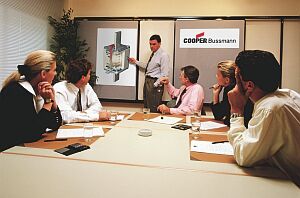Fuse maker Cooper Bussman operates a technical helpline for its customers. We asked its technical expert - Tony Warren - to list the most frequently asked questions:

What is I2t?
All fuse links are given an I2t rating or value. This value simply represents the amount of electrical energy that the fuse will let through before clearing the fault and therefore defines the electrical characteristics/speed of the fuse link.
What's the difference between BS88 and NH?
Electrically there is very little difference between BS88 (or British Standard fuse links) and NH fuse links. Both conform to the general requirements of IEC60269, and both are regarded as high breaking capacity fuses links. Where they differ greatly is in the mechanical characteristics. The distinctive round body of the British Standard fuse link differs greatly from the NH system, which uses solid bladed knife tags without the need for bolts, and a square ceramic body.
Is it true that fuse elements age?
No this is a myth. In fact, one distinct advantage that fuse links have is that they are resistant to the effects of ageing.
Can I re-wire a fuse?
Generally it is not common practice to re-wire HRC fuse links. HRC fuse links should not be confused with the re-wireable consumer unit links found in domestic applications. Generally, these are used to protect final circuits where the levels of short-circuits are far lower than those encountered in commercial or industrial applications. There are however some special fuse types where the element can be replaced, such as liquid fuse links.
What fuses do I need when I export equipment to the US or Canada?
Fuses fitted to equipment destined for the US or Canada must meet the standards of the North American electrical system. These fuses must be listed to the applicable UL and/or CSA standards. There are key differences in characteristics of UL/CSA fuses when compared with BS or IEC. Fuse links conforming to North American standards are not dissimilar in appearance to BS/IEC designs. Fuses rated up to 60A are generally cylindrical, and higher ratings are fitted with tags for mounting in spring contacts, or slotted tags to allow a bolted connection. UL (Underwriters Laboratories) and/or CSA (Canadian Standards Association) standards written by these institutions have led to the establishment of several distinct classes of fuse links.
What is arc voltage?
The arc voltage is the sum of all the voltages developed across a fuse element, end to end, during operation. In a low voltage fuse this is typically a single arc, in medium voltage fuses the arc voltage is usually the combination of a number of arcs in service. For a fuse to operate correctly, arc voltage must be at least twice the system voltage.
Can I replace a fuse with a similar product from a different manufacturer?
International standards and institutions govern most fuse products manufactured today, so the performance and dimensional characteristics are often comparable. This enables many fuse products, particularly industrial fuse links, to be interchangeable. Careful consideration should always be given however, as no two fuse types are identical both electrically and mechanically. Manufacturers produce cross-reference material to make the decision-making process that much easier. If in doubt, always contact the manufacturer.
Why don't the amp ratings of competitors' semiconductor fuse links always match?
You may come up against this often when matching semiconductor fuse links. The reason for this is that, uniquely, semiconductor fuse links are all about speed of operation. They never normally experience low overload situations, so the actual amperage rating is not as important as the speed of the fuse link itself.
For example, you might find that a particular fuse link at 180A from one manufacturer is the same (with respect to speed of operation) as a 200A fuse link from another. For general-purpose fuses this difference would be unacceptable. However, with high-speed fuses it is acceptable to match on speed rather than amperage.
Why do I need a high-speed fuse, won't a standard fuse be just as good?
High-speed fuses are specifically designed to operate very fast in the event of a sudden surge in current due to a short-circuit. Semiconductor devices cannot withstand these high levels of current and would rapidly be destroyed.
A high-speed or semiconductor fuse link will operate before the I2t has reached a level at which the semiconductor device would be irreparably damaged or destroyed. Generally, industrial fuse links have an I2t let-through which is around 10 times that of a high speed equivalent.
Which fuse holders suit high speed semiconductor fuse links?
Semiconductor fuse links run much hotter in service than conventional types. They are therefore generally mounted directly in the equipment so that air can circulate around them. Enclosed holders are not normally used.
This article was first published in Electrical Times magazine (October 2003 issue) and has been used courtesy of publisher and Voltimum UK partner Highbury Business Communications.
Electrical Times
Highbury Business Communications
Nexus House, Azalea Drive,
Swanley, Kent BR8 8HY
Tel: +44 (0) 20 8722 6072
Email: [email protected]
Web: www.hhc.co.uk
And: www.electricaltimes.co.uk
Contact: Bussmann Division
Cooper (UK)
Burton-on-the-Wolds
Leicestershire LE12 5th, UK
Telephone: 01509 882737
Fax: 01509 882786
Email: [email protected]